Do you want to learn coding to become a freelance web developer and achieve financial freedom in life?
Freelancing is the fastest way to make money with coding, but knowing where to start can feel scary and overwhelming for most beginners.
What if I told you it’s possible to start making money as a freelance web developer in 2–4 months?
With that said, let’s set the right expectations here. You won’t make a full-time income from the get-go. This isn’t a get-rich-quick scheme.
If your goal is to begin earning tons of money tomorrow (before you learn and build the skills), then you’re not going to make it very far. Becoming a freelancer takes a lot of hard work, so it’s not for everyone.
But if you are ready to commit to learning the right skills that help you become a successful freelancer, you are in the right place.
The good news is:
You can earn money from freelancing while you’re still learning how to code.
You don’t need to spend tons of time and money on courses or bootcamps. With the right resources, you can become a freelance developer even on a shoestring budget.
In this guide, I’ll show you how I started teaching myself to code, quit my job and became a full-time freelance web designer and developer in a matter of months.
However, that didn’t happen overnight. My freelancing success is the result of a lot of self-discipline, strategic positioning, and hours of hard work.
This guide is based on my personal experience. Hence, your journey could be entirely different, or very similar.
Either way, please share your thoughts in the comments section! I’m more than happy to answer any questions you may have.
I broke down my journey into 13 practical steps so that you can use this guide as a step-by-step roadmap more easily.
Let’s jump right in!
Here are a few related posts you may want to read, too:
- The Best Way to Learn Coding: Beginner’s Guide
- Which Programming Language Should I Learn? The Ultimate Guide
- How to Become a Web Developer? FAQ: Salaries, Careers, Skills
Please note: This post contains affiliate links to products I use and recommend. I may receive a small commission if you purchase through one of my links, at no additional cost to you. Thank you for your support!
Why should you start freelancing?
If you are interested in coding and web development, I assume you want to make money coding in the future, right?
You have plenty of options to choose from career-wise. You can:
- Become a full-time developer
- Start your own business
- Sell courses and tutorials online
- Create and sell apps
But the truth is: the road to a full-time job or to starting your own business can be long and rocky.
To get job-ready, you need to learn and practice all of the required skills by yourself.
It’s difficult to build up your confidence because you can’t validate your skills until you actually land your first job.
When you start learning a new skill, you simply have to believe that you are “good enough”.
But what if you could get real feedback on your work right away?
What if you could feel confident in your skills, knowing that you can use them for real-world projects?
This is where freelancing steps in.
Even if you are relatively new to learning tech skills, you can find small freelance gigs and gain real work experience to improve your skills.
When you are ready to apply for your first full-time job, you can showcase real work samples and projects to potential employers. You will also have real testimonials form real-life clients, which is something no coding course out there can offer.
Plus, you will make money on the side – while still learning.
I mean, you need to build projects anyways when you’re learning to code. You need a portfolio with relevant projects to land your dream job. So why not build them for a real client and get paid in return?
Pursuing small freelance jobs back in 2017 was the best decision I ever made. It allowed me to gain confidence and make money even though I was still new to coding.
So I know how difficult it is to know where to start if you are a complete beginner.
That’s why I put together this guide. It covers everything I wish I knew when I was in your shoes. If you are interested in earning a side income while learning, drop me a line in the comments section and I’ll help you get started!
Related: How to Start Learning Coding? 6 Simple Steps For Beginners
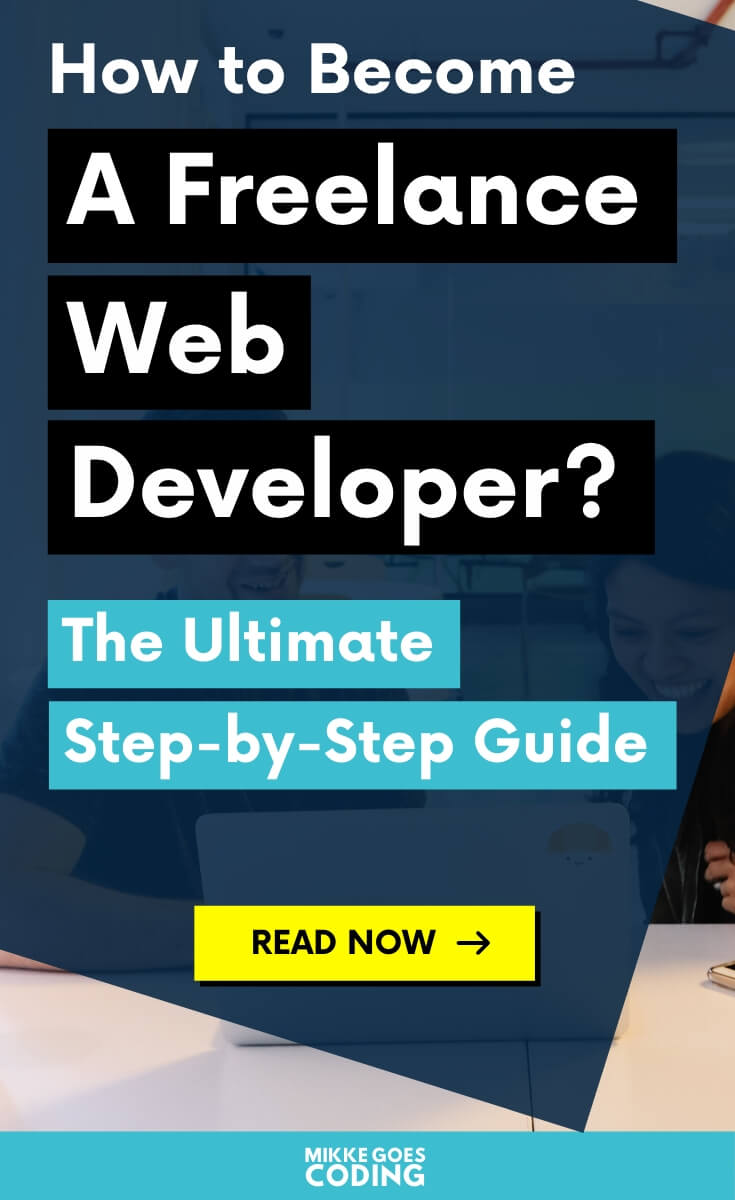
How to become a freelance web developer: 13 practical steps
If you want to make money as a freelance web developer, you need to have a clear goal and a solid plan to achieve it.
Here’s how to become a freelance web developer step-by-step:
- Define your goals and know your “why”
- Break down your long-term goals
- Focus on your strengths to find your niche
- Define who is your ideal client
- Learn the skills to make money with
- Update your LinkedIn profile
- Register a domain and sign up for web hosting
- Set up an online portfolio website
- Sign up to an online freelancing platform
- Practice by building meaningful projects
- Apply to your first small freelance jobs
- Deliver stellar results to get your first testimonial
- Rinse and repeat – and keep learning!
Let’s look at each of these in more detail.
Related: Web Developer Certification: Is It Worth It?
Step 1: Define your goals and know your “why”
If you’re serious about becoming a freelance web developer and you want to make money coding, the first thing you must do is figure out why you’re doing this.
Related: 8 Essential Things to Know Before Learning Coding
We all have different goals and desires when it comes to freelancing. You might want to learn slowly and work part-time for a little side income. Or you might want to learn web development as quickly as you can and quit your job to pursue a new career.
Whatever you want to achieve with coding, make sure you define your goals right now.
Also, know your “why”. Why do you want to start freelancing as a web developer?
Here are a few examples:
- Achieving more freedom in your life
- Being able to travel and work remotely
- Starting your own freelancing business in the future
- Earning a higher income
- Breaking free from the “9 to 5 purgatory”
Your “why” will be your #1 motivator along the way. Make sure you are absolutely sure about why you are doing this.
For example, I had three reasons to start freelancing:
- I wanted more freedom in life
- I wanted more financial flexibility
- I wanted to spend more time with my family and friends
I never want to wake up too early in the morning, sit in an office all day, and work for a company that doesn’t appreciate my time.
Instead, I want to choose what I do with my time, when I work and travel and who I work with.
I want to be my own boss.
This freedom allows me to take care of my parents and spend time with people I love and care about.
So, what’s your “why”?
Related: Why Learn Coding? 12 Essential Benefits From Learning Programming
Step 2: Break down your goals
When you start learning to code and want to start freelancing, the journey may feel daunting and overwhelming.
That’s when you can start feeling frustrated and discouraged – which is something we want to avoid at all costs.
To maintain your focus and motivation, you want to break down your goal into smaller milestones.
This helps you track your progress and see how far you’ve come already.
For example, let’s say you want to start freelancing to earn a six-figure income in the future. That’s a fine goal!
But it may be a huge leap from your current situation.
To make things easier for yourself, you could think of it this way:
- Earn $120,000 / year in 2 years from now. Woah, that’s a big goal!
- That’s $10,000 / month. Still big, but not as daunting.
- Let’s assume you earn $0 from freelancing right now. You got to start at the bottom, right?
- You have 24 months to increase your monthly earnings to $10,000.
- Your monthly income needs to grow by $417 every month. Not that bad!
Crushing the number into smaller steps makes it easier to grasp how much work you need to put in every month.
Even big goals feel less scary and overwhelming this way.
How about starting with $1,000? Find out how I made my first $1,000 freelancing here.
Step 3: Focus on your experience, knowledge, and strengths
Now that you’ve figured out your goals, you need a way to get there.
If you wish to start freelancing as a web developer, you need to focus on a specific niche.
Remember: your future clients are looking for someone to solve problems for them.
To stand out from the competition, you have to offer targeted solutions better than your competitors.
It will be easier to find work and deliver great results if you find an area where you have experience in or knowledge of already.
Also, at the same time think about your weaknesses.
Is there something you don’t want to do?
Freelancing is your best chance to get full control over your life. So you might as well be picky and choose to work with things you genuinely enjoy.
Before I became a web developer, I worked as an analyst in finance and aviation. Some of my strengths were:
- Analytical thinking:
I had learned a lot about figuring out complex models and interdependencies. Somehow I was always able to make good decisions and achieve good outcomes, too. Ok, almost always. - Creativity:
I really loved being creative in my work. Even though it was always very quantitative and technical, I got great feedback for my creative touch. - Teamwork:
I wasn’t the most active speaker, but more of an analytical mastermind. I didn’t necessarily say much right away. But after processing all the input I usually had valuable input for everyone.
These strengths helped me find my first jobs, focus on the right clientele, and start my own business.
Step 4: Define who is your ideal client
Once you know your strengths, it’s time to figure out who you want to work with.
Remember: even if you are new to freelancing, you shouldn’t take on every client you can get.
Ask yourself:
Who do I work best with?
Knowing the type of businesses you want to work with helps you pitch your services more easily.
When you work with similar clients, your portfolio will automatically become more convincing, too.
Showing potential clients how you’ve helped other businesses with similar problems they’re struggling with means you will jobs more easily in that field.
To define your ideal client, ask yourself these questions:
- What type of businesses struggle with problems I can solve with my services?
- Will my clients be small businesses, other freelancers, large corporations, or tech startups? Or something else?
- Which industry will I focus on?
- Can the businesses I want to work with afford to hire me?
- Who will be the decision makers in the businesses I target? What common ground do I have with them?
It all boils down to knowing who you feel comfortable working with, so that you can establish yourself as an expert in that niche and industry.
In my freelancing business, I mostly focus on small businesses who have little technical experience and know-how. That way, I can take care of everything tech-related and set up a website or an online shop for them from scratch.
The reason I prefer these jobs is because it’s much easier to build a system from the ground up than to optimize, extend, or fix existing ones.
Most of my clients have a similar background with me. They’ve turned their freelance careers into successful, small businesses just like I did. Having common ground like that is essential for building trust and understanding the problem areas within their businesses.
So, who do you want to work for as a freelancer?
Be mindful of your long-term plan here. You may want to work with enterprise-sized companies and establish longer-term contracts with them.
But when you are looking to break into freelancing, you can’t expect to land a $50,000 job right away.
Hence, be strategic about your ideal client. Identify the industry you want to focus on. Work with small clients first to gain experience and to build your portfolio.
Step-by-step, start pitching your services to larger clients, and work your way towards those enterprise-scale jobs.
Step 5: Learn the skills you need to make money freelancing
Now that you know the niche you want to focus on, it’s time to roll up your sleeves and get to work.
First of all, you need to remember that becoming a freelancer is just like starting any other business.
You need to learn all the skills you need to get hired, do the job, and take great care of your clients.
That being said, to become a web developer and make money freelancing, you should consider at least these skill sets:
Web development and web design skills
- HTML and CSS
- JavaScript and jQuery
- PHP and WordPress
- Responsive design and development
- Popular front-end frameworks (e.g. Bootstrap)
- User experience (UX)
- Server-side languages: Python, Java, Ruby
- MySQL and database management
- Development tools and software
Complementary skills
- SEO keyword research, competitor analysis, SEO strategies
- Copywriting, content marketing, social media strategy
- Back-end development: programming languages (Python, Ruby, Java), MySQL and database management, development tools and software
Make sure you check out my article on the best programming languages and tools for freelance web developers.
It’s perfectly OK to learn coding and web development using free resources. Check out my master list of 120+ place to learn to code for free.
However, I recommend investing a few bucks in a quality course if you can. They usually have a more comprehensive and project-based curriculum.
Plus, you have an incentive to get a fair return on your money. Therefore, you are more likely to finish a course that you paid for – even if it’s just $10.
Furthermore, I recommend starting a web development course where you learn the basics of several different tools, not just one programming language.
If you’re not sure where to start, check out these 5 web development courses for beginners.
The two courses I took before I landed my first freelance jobs were:
- The Complete Web Developer Course 2.0 on Udemy, followed by
- The Complete WordPress Website Business Course, also on Udemy
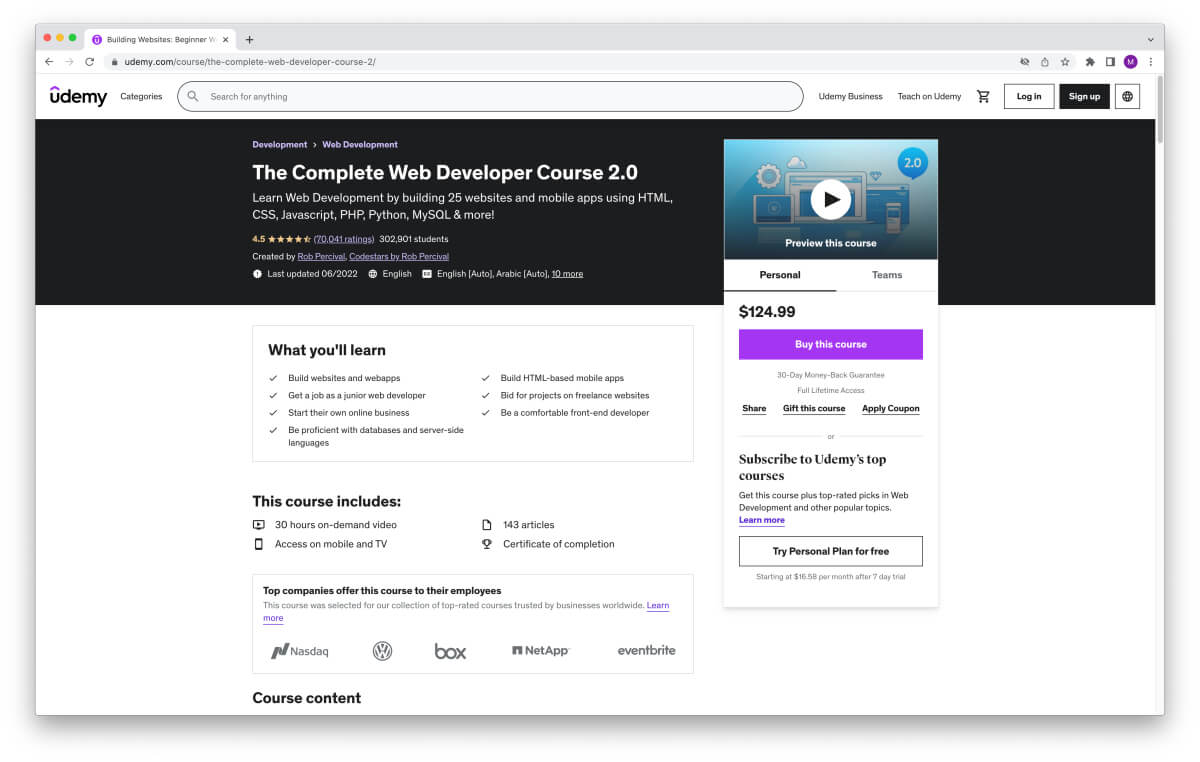
I purchased both courses during a promotion on Udemy for a total of $19.98.
Needless to say, the investment paid off big time.
If you’re not familiar, check out my full Udemy review.
Step 6: Update your LinkedIn profile
Alright, time to go online and become a freelancer overnight!
You see, when you know what you need to learn to achieve your goals, you can start building an online reputation step-by-step.
The first thing you want to do is to update your LinkedIn profile. And if you don’t have one already, make sure you sign up now.
Why?
Because LinkedIn is the best platform for not only finding new contacts but also for putting yourself and your work “out there”.
You’ll be surprised by how quickly people find you and perhaps even get in touch with you about potential jobs, too:

You can start by writing a short info in your profile about the skills you’re learning.
Whenever you feel proficient with a new tool, don’t hesitate to include it in your profile.
Later on, when you start building your first real-life projects, upload them to your portfolio website and share every project on LinkedIn, too.
Speaking of portfolios…
Step 7: Register a domain and sign up for web hosting
A professional portfolio website is a must-have for any freelance web developer and programmer.
It is your #1 tool for promoting your skills and selling your expertise to potential clients.
When I launched my freelance portfolio website back in 2017, I only had two simple projects to showcase.
But I created enough content to make sure my potential clients would see the value I could deliver.
And it paid off: I targeted my local area with a few key SEO techniques and landed my first big jobs within a month.
Where to get your domain and hosting?
To build a web developer portfolio, you need two things:
- Domain name
- Web hosting
If you’ve never done this before:
Your domain name is what people type into the URL bar in their browsers.
A web hosting account is the web space where your portfolio website files “live”.
Registering a domain name and signing up for web hosting is the only absolutely necessary investment if you want to make money online as a freelance web developer.
But when you are just starting out, you don’t want to spend more than you need to.
That is why I have teamed up with Bluehost for an exclusive web hosting deal starting at just $2.95 per month – including a free domain name.
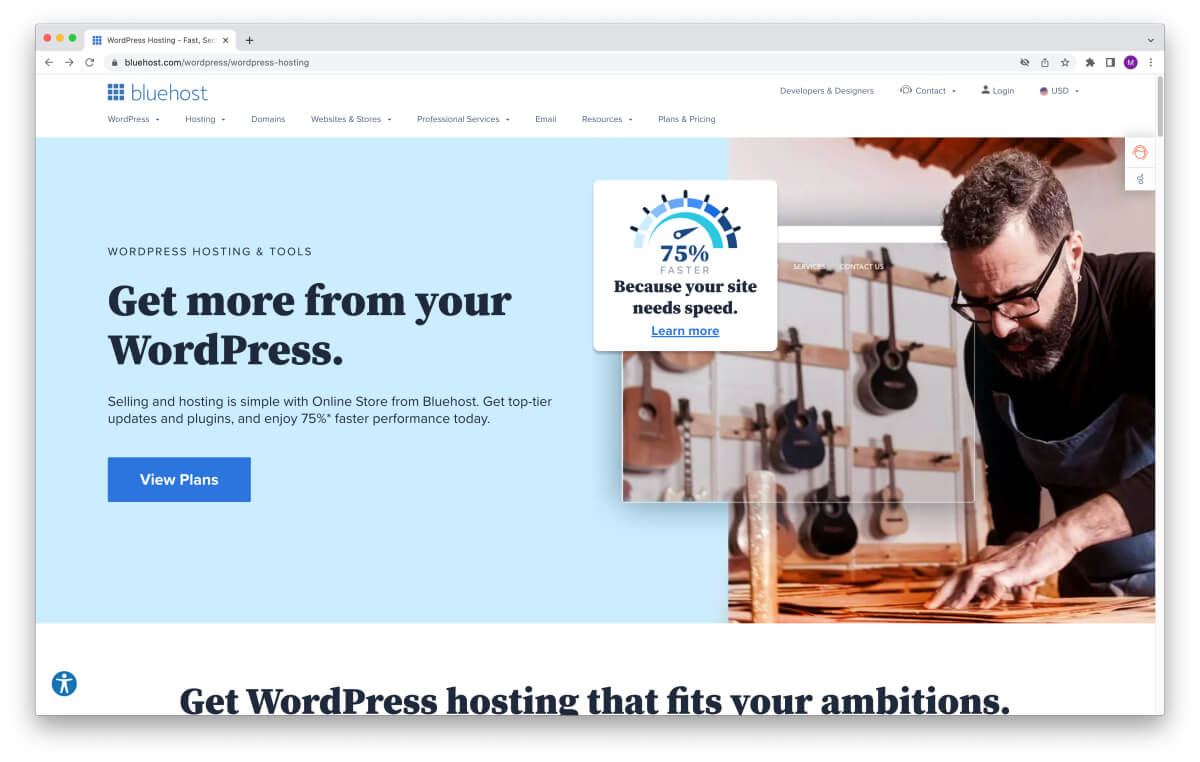
And yes, I’m not shy about my cooperation with Bluehost. I’ve hosted websites with them since 2016. Out of all hosting providers I’ve worked with, they’ve offered the best value for my money.
Ideally, you want to find a hosting provider who you can recommend to your clients, too.
This will help you save time when you’re managing your clients’ projects, since you know your way around the admin dashboard.
For a full guide, check out my post on how to choose the best web hosting for your website.
Step 8: Set up an online portfolio website
When you domain name and web hosting are set up, it’s time to create a basic freelancer portfolio website for yourself.
If you’re new to this, head over to my free portfolio tutorial to build your freelance portfolio website step-by-step.
As for the tools you’ll use, you have two options:
- Build your website from scratch:
You can build your portfolio website from scratch using HTML, CSS, JavaScript etc. This is a fantastic opportunity to get real-world practice. - Use a Content Management System (CMS):
The more convenient option is to use a CMS like WordPress. It allows you to build a professional-looking portfolio in a matter of a few hours.
Now, you might be asking:
Why should I use a ready-made solution if I’m trying to learn how to code things from the ground up?
The truth is: you will learn how to build a website from scratch eventually.
But as you do, you’ll learn coding faster by building projects for your portfolio. Setting everything up for your first projects saves you tons of time, trust me.
Also, you will learn how to build websites using WordPress as you go about tweaking around with your portfolio. And the demand for WordPress developers is skyrocketing as we speak.
In fact, so many businesses use WordPress that it’s my #1 tool for building and managing my clients’ websites. In other words, WordPress pays my bills these days.
Read more in my full guide on why you should use WordPress for your website projects.
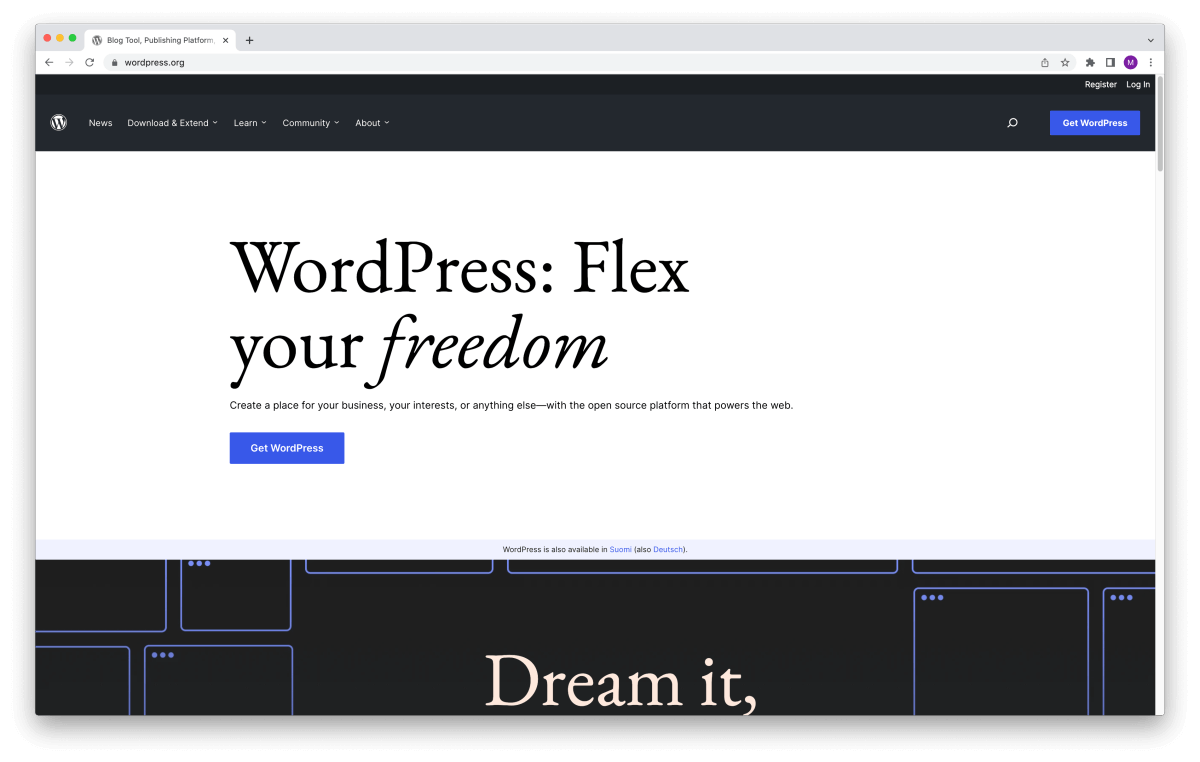
However, keep in mind that you MUST learn the skills I listed above (HTML, CSS, JavaScript etc.) before you start building WordPress websites for your freelance clients.
You also need to learn the PHP programming language to understand what’s going on if you run into problems with WordPress.
Now head over to my article with the 10 most essential things to include in your freelance portfolio website to get started!
Step 9: Sign up on a freelancing platform like Upwork
The reason why you should sign up to an online freelancing platform now is simple: you want to do some research about the job market.
You want to find out what types of jobs are available in your field. This will help you focus on learning the right skills later on and know that there’s demand for them.
Freelancing is basically all about finding clients who have a problem you can solve with your skills. As long as you know you’re learning a skill that’s in demand, you don’t have to worry about finding work.
That being said, here are a few popular online freelancing platforms you can take a look at:
You can choose a platform you like the most at this point.
If you’re not sure which one to go with, Upwork is a safe choice. I used it to start freelancing and I was 100% happy with everything.
To get started the right way, follow my step-by-step tutorial on how to create an Upwork profile that stands out.
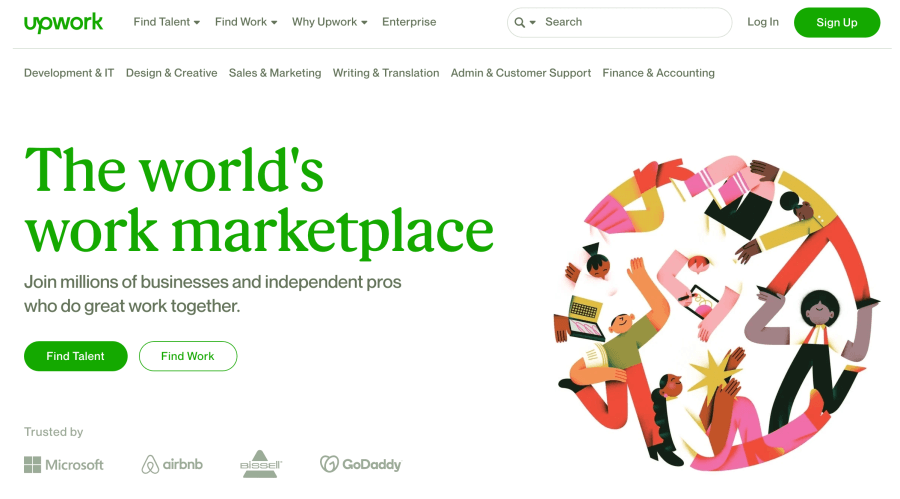
Once your profile is set up, start browsing job openings in your niche. Use appropriate filters to find small, low-budget, beginner-level jobs.
See which skills are in demand and what you need to learn and brush up to apply for your first freelance job.
Even if you are just getting started, you want to be aware of what client need from you. You want to have a clear idea of what skills are relevant for landing your first job starting now.
Related: How to Become a Web Developer? 4 Essential Tools You Must Learn
Step 10: Practice by building meaningful projects
Getting hired on online freelancing platforms is much easier when you have a suitable portfolio to showcase your skills.
It doesn’t matter how good a programmer or web developer you are if you can’t show your clients how you can solve their problems.
That being said, based on your research on the online freelancing website of your choice, it’s time to start building your first portfolio projects.
Basically, you only need to focus on one thing: showing that you can deliver value to your potential clients.
Thus, if you saw tons of small freelance jobs with HTML and CSS adjustments, build a couple of portfolio projects from scratch using HTML and CSS.
If you found interesting gigs with beginner-level JavaScript and jQuery work, build a small portfolio project based on JS.
(See the pattern here?)
In short: build a portfolio to show your future clients how you can help them. Focus on the outcome, not the technical skills per se.
Find out what they’re struggling with. Then present them with a solution.
Here’s some inspiration for your first front-end projects:
- 32 HTML And CSS Projects For Beginners (With Source Code)
- 24 JavaScript Projects You Can Build to Perfect Your Coding Skills
Step 11: Apply for your first freelance jobs
When you’re just starting out learning coding and web development, you might feel like it’s too early to look for jobs.
And I know how overwhelming it feels. You might feel like you’re not ready or good enough yet.
I was practically terrified when I sent out my first job applications on Upwork. I kept comparing myself to others, all the time. That was a big mistake.
Of course, it’s impossible for you to deliver the same results as a professional developer with years of experience. But in general, most beginners underestimate what they’re capable of.
Thus, as soon as you are confident in your skills, apply for your first job on Upwork.
Here are a few helpful tips to get started:
- Start with small jobs like fixing website layouts or updating HTML content like contact information on a client’s website.
- Keep your bid low, explain that you’re just beginning and you’re willing to work for less for your first review.
- Make sure you understand what the client wants and don’t take on jobs that are too big.
Trust me, as long as you can solve their problem and your communication is prompt and professional, you will get your first job sooner than you think.
Step 12: Deliver stellar results for your first testimonial
Getting your first freelance job is a huge milestone – congrats!
Whether it pays $5 or $100, all that matters is that you just got hired.
Now, take a deep breath in and keep your eyes on the prize. This job will earn you your first testimonial for your freelance portfolio website.
To help you get going, here are three points you should keep in mind:
- Communicate promptly:
Whatever happens, stay in touch with your client and be honest about the outcomes. - Be reliable:
Avoid taking on jobs that are too demanding. You’re still learning, so the best way to guarantee solid quality is to focus on jobs that seem a tad too easy. It’s better to finish two easy jobs than to mess up a difficult one and back down from the project. - Respect deadlines:
If someone is buying a solution from you, they’re expecting you to deliver on time. Your work could be part of a bigger project, so your deadline affects others working on the same project, too.
When you’re finished with the project, consider going the extra mile for your client. Surprise them with a helpful feature or a small but valuable addition they weren’t expecting.
Remember, you’re still learning, so you can do a bit more than what the client asked for without worrying about the extra time spent. With these first jobs, your primary goal is to learn more and practice, not to get rich.
For example, add some custom CSS to improve the look and feel of the project. A few simple CSS @media queries can work wonders on the responsiveness of any website.
Or if you built a WordPress website, add a helpful WordPress plugin for your client.
Step 13: Rinse and repeat – and keep learning!
Now that you’ve finished your first project and earned your first freelancer paycheck, it’s time to look for the next one.
When you receive your first testimonial or review, it’s much easier to find your next job. In the early stages, keep your bids relatively low, go the extra mile, and add new projects to your portfolio.
At the same time, make sure you keep learning and improving your skills.
By working with various different clients and building multiple small projects, you will quickly learn how to manage your projects and clients efficiently.
Remember to take any feedback you get and learn from it.
You will be surprised how quickly your skills improve. You will learn how to finish projects faster, allowing you to get more clients and grow your earnings.
Once you start earning a nice side income, you have a few paths to choose between:
- Become a full-time freelancer:
If you enjoy freelancing, you can pursue it full-time like I did. Make sure you have a reliable client base before you transition and quit your job. - Keep freelancing as a side gig:
If you’re happy with your current job, freelancing on the side is a great way to earn some extra money. - Apply for a full-time developer job:
If a full-time developer career is you goal, you now have a portfolio of real-world projects and testimonials from real clients.
What’s it going to be? Let me know in the comments below!
General FAQ: Freelance web developer career
Working as a freelance web developer means you are self-employed, working for multiple clients and on several different projects at once. Freelancers can work for clients online or offline, locally or globally, from home or remotely.
To become a freelance web developer, you must start by defining your goals. Then, break them down on a monthly and weekly level.
Find your niche based on your skills and set up an online portfolio website. Sign up to an online freelancing platform to find your first small jobs, earn your first positive reviews, and practice on side projects on your own. Step-by-step, find bigger, higher-paid jobs to build a full-time income as a freelancer.
According to ZipRecruiter, the average freelance web developer makes $65,003 per year in the U.S. (April 2023), meaning the average rate is approximately $31 per hour.
The easiest freelance websites with the largest pools of beginner-level jobs in 2023 are Upwork.com, Freelancer.com, and PeoplePerHour.com.
According to Upwork.com, the markup and programming languages with the highest demand for beginner-level jobs are HMTL, CSS, JavaScript, and PHP. For advanced-level jobs: PHP, JavaScript, HTML, CSS, and Python.
The easiest way to find freelance web developer jobs is to look both offline and online. Approach local businesses and your personal contacts, but also sign up for an online freelancing platform like Upwork.com.
Your hourly rate depends on your (1) location, (2) skills and experience, and (3) your clients and niche. Beginning freelancers charge between $20–50 per hour, senior web developers anything between $120–450 per hour.
Final thoughts: How to become a freelance web developer
Even if you’ve never worked for yourself before.
Even if you’re just getting started with learning how to code.
You can start making money from coding in a matter of weeks or months.
In this post, you’ve learned how to become a freelance web developer. You have all the tools you need to start building a freelance business starting today.
It will take a lot of hard work to achieve a steady income. But trust me, your effort will pay off.
The most important thing is to maintain your focus. When you have a long-term goal to strive for, small setbacks won’t feel as tough, trust me.
If you are ready to take action and start right now, grab your copy of my popular beginner’s freelancing guide.
It will show you how you can start making money from small freelance gigs, and leverage that into a full-time freelance career.
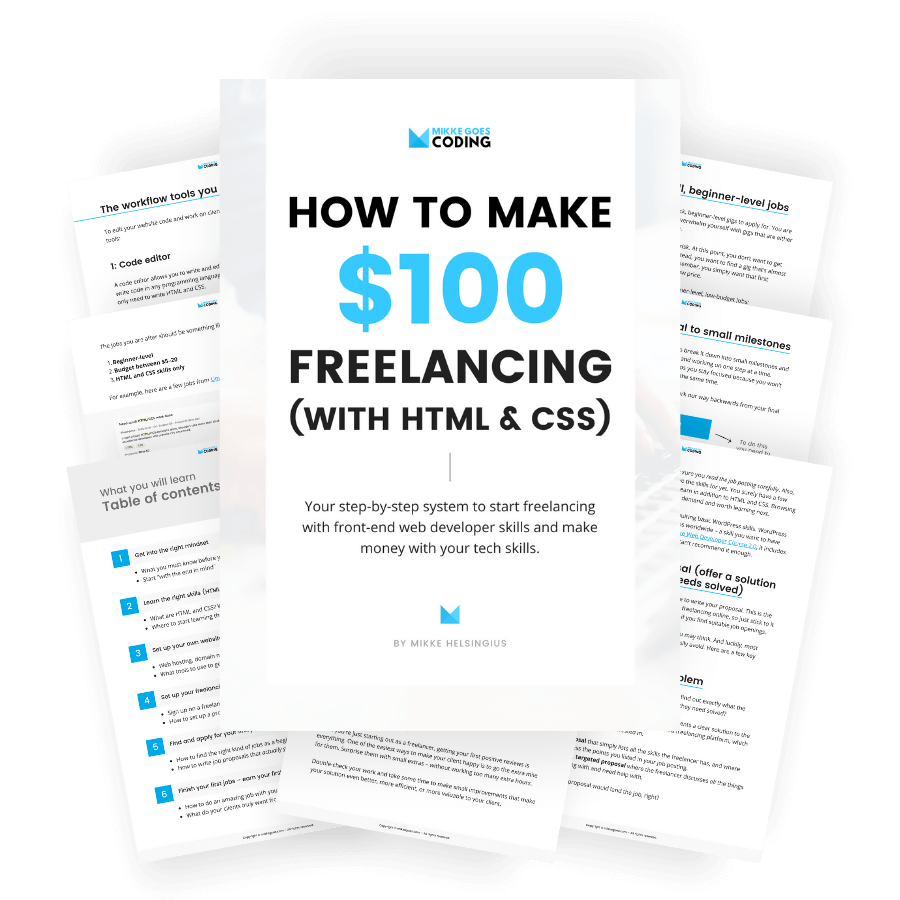
I’ll see you in the next post!
– Mikke


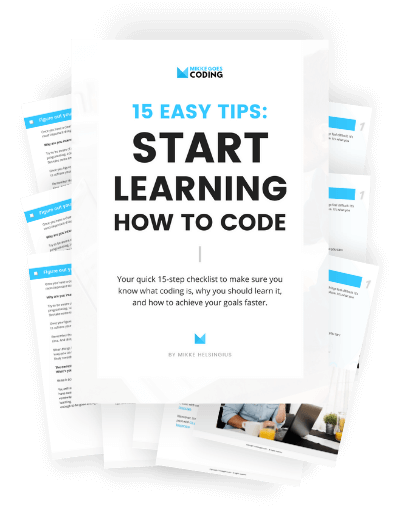
Very interesting article Mikke, thank you. 🙂
This a great article Mikke! I have a question, how do Web Developers edit or upload html/css files to a site that has a domain owned by another person?
Thank you Mikke .